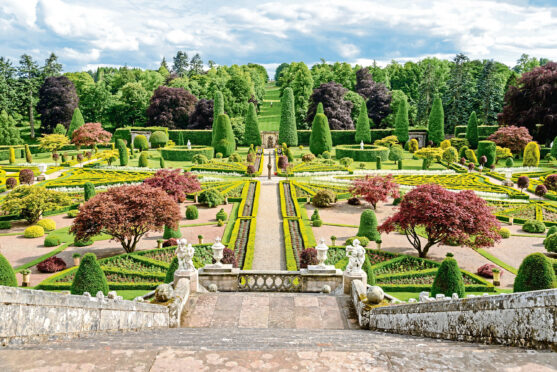
Situated in the small village of Muthill, just 4km (2.5 miles) outside Crieff, you’ll find Drummond Castle Gardens – stunning grounds which date back to the 17th Century.
The original garden was given a complete overhaul and French-style terracing in the early 19th Century, praised by Queen Victoria during her visit in 1842. The gardens as we see them today were replanted in the 1950s.
The grounds are attached to Drummond Castle, originally built for John, the first Lord Drummond, in 1490. The castle as it is now can be credited to the work of the first Earl of Ancaster, 400 years later in 1890.
The castle is owned by Jane Heathcote-Drummond-Willoughby, 28th Baroness Willoughby de Eresby and is not open to the public. However, visitors to the gardens are given a fantastic view up to the grand building.
On screen
Drummond Castle Gardens are a popular spot with visitors and tourists, and have been for decades.
Many modern-day tourists will recognise the gardens thanks to their appearances in both an episode of the second TV series of Outlander – standing in for the gardens of Versailles – well as the 1995 film Rob Roy.
Claire Wallace, manager of Drummond Castle, believes that the historical aspects of the gardens really strikes a chord with those who visit.
“Their history makes Drummond Castle Gardens so special,” says Claire. “There is evidence to support a long history of gardening at Drummond from the late 15th Century.
“There is, of course, the obelisk sundial which dates back to 1630 and is at the centre of the parterre design.”
Viewed from above, the parterre garden design is a St Andrews Cross, a nod to Drummond Castle Garden’s proud place as one of Scotland’s foremost horticultural delights.
The gardens are home to a wide array of plants and trees, all set out along paths which offer easy access.
Keep an eye out for the copper beech trees planted by Queen Victoria in 1842.
Spectacular greenery
The stunning displays of greenery don’t just begin when you reach the gardens. The road up to the car park and castle courtyard is lined with trees, a bold first impression which only improves as you explore.
With the season coming to a close on October 31 before the gardens reopen for the Easter weekend, Claire believes now is the perfect time to visit.
“I love the tranquillity and peacefulness of the gardens and its changing seasons – especially the autumn colours,” she says.
These magnificent gardens need to be seen to be really appreciated. A place of colourful grandeur, each visitor has their own personal favourite part of Drummond Castle Gardens.
In Claire’s experience, though, two sections in particular always amaze.
“Visitors enjoy the beech tree avenue – first planted in the late 18th Century and more than a mile long – and the magnificent first viewing of the gardens from the top terracing.”
With an abundance of nature to take in, it’s little wonder that Drummond Castle Gardens have been impressing visitors for more than 400 years.

Enjoy the convenience of having The Sunday Post delivered as a digital ePaper straight to your smartphone, tablet or computer.
Subscribe for only £5.49 a month and enjoy all the benefits of the printed paper as a digital replica.
Subscribe